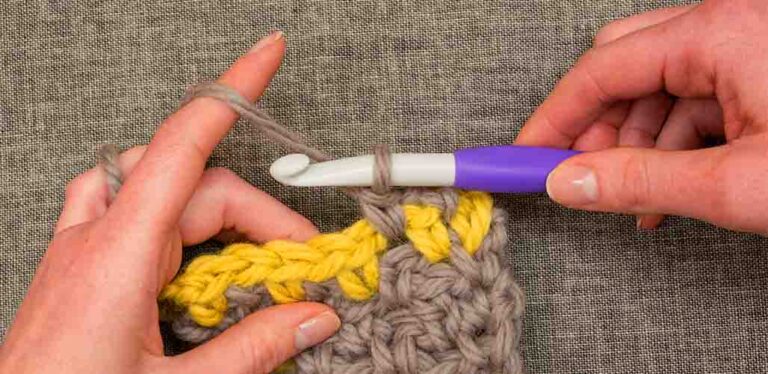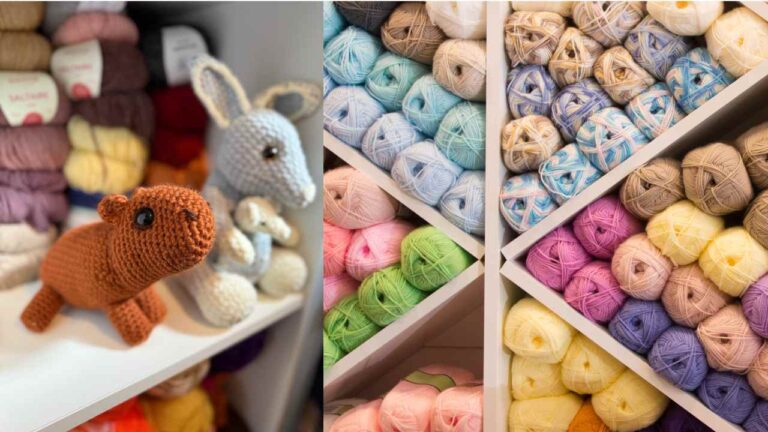Cotton Vs Acrylic Yarn
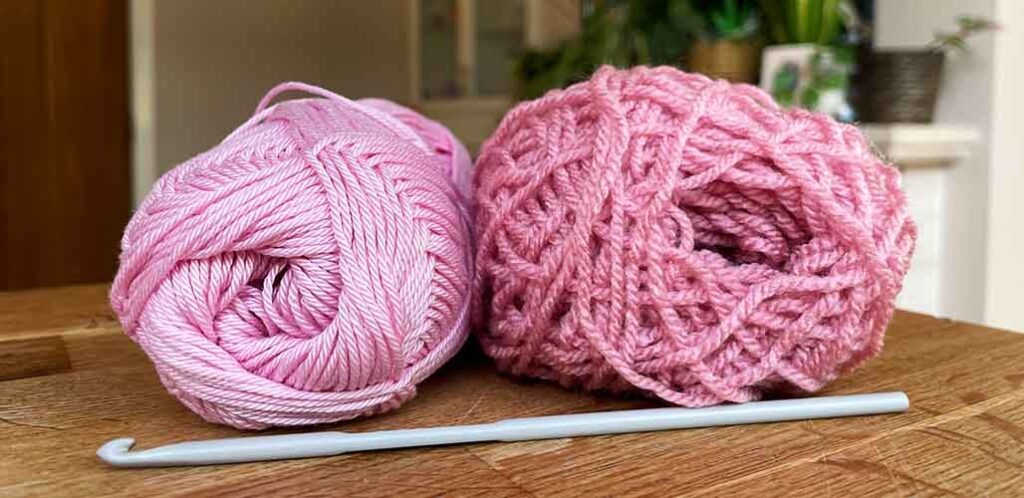
Once upon a time the differences between cotton vs acrylic yarn were huge. Cotton yarns were stiff, heavy and rough, but natural and ultimately biodegradable. Acrylic yarns were light and squashy, but synthetic and sweaty. Fast forward to now and some cotton yarns are silky soft, and some premium acrylic yarns are made from recycled plastics and barely distinguishable from real wool. So how is anyone meant to choose? By reading this article! Here are all the different ways acrylic and cotton yarns compare, and how to pick between them for your next project.
- What is cotton vs acrylic yarn?
- Comparing the two
- Working with acrylic vs cotton yarn
- Making your choice
What is cotton vs acrylic yarn?
There’s no mystery here really: cotton yarns are spun from cotton, a natural fiber harvested from the seed heads of cotton plants. And acrylic yarns are spun from synthetic fibers derived from fossil fuels. Cotton has been used in textile making for millenia, whilst acrylic yarns were developed in the 1940s as a cheaper substitute for wool.
Thanks to these origin stories, cotton is widely perceived as being ‘better’ or more wholesome than acrylic yarn. But what about in your crochet projects? Well, it’s significant that acrylic yarns were created as an alternative to wool, not cotton. So their properties mimic woolen fiber, not cotton fiber. This means you can’t use cotton or acrylic interchangeably in all situations. But, modern yarn making techniques have definitely blurred the a lot of the differences that originally existed between the acrylic and cotton yarns.
Comparing the two
Here are some important fiber properties, and how acrylic vs cotton yarns compare:
Texture
Comparing cotton vs acrylic yarn texture is complicated by the fact there’s a lot of variation between the different types of cotton yarn, and from one acrylic yarn to the next as well. Traditionally, cotton yarns were rougher to touch, more rigid, and had little stretch or ‘give’ in them, when compared to wool or acrylic. But these days, many cotton yarns are made smooth and soft through a chemical treatment process called mercerization. And some cottons are spun, or ‘plied’ in a way that makes them more squishy and stretchable than ever before.
On the other hand acrylic yarns have always been stretchier, squashier, and better for crochet projects which need a bit of drape. They’re also inevitably more fuzzy than cottons. In these pictures you can see how the fuzziness of acrylic yarn (bottom square) completely changes how much stitch definition you can see compared to using cotton yarn (top square):
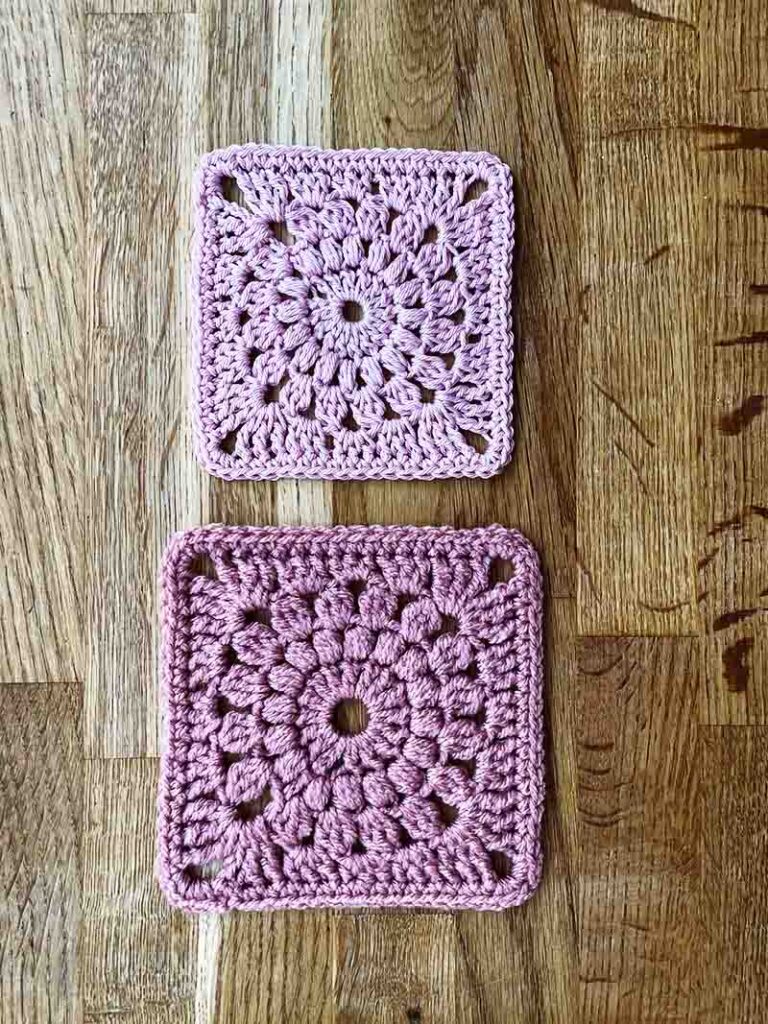
Weight
Cotton yarns are significantly heavier than acrylic yarns. In the photo above, both yarns were labeled as DK weight, and both granny squares were worked on a 4mm crochet hook. But despite the cotton square ending up smaller, it still weighs more than the acrylic square. If you specifically want a light cotton yarn, look out for S-on-S plied cotton yarns such as Bernat Softee Cotton and Caron Cotton Cakes. S-on-S plied yarn structure is more airy than regular twisted yarns, and therefore lighter. But not as light as acrylic.
Water absorbency
Cotton and acrylic yarns respond very differently to water. Cotton yarns absorb water easily, and can hold a surprising volume of it! In fact it takes in water so easily that some crocheters find that working with it even dries the skin on their hands out. Since cotton holds on to water so readily, it also takes longer to dry after washing too.
On the other hand, acrylic yarns are hydrophobic. They hate water. This means they dry quickly after washing, but it also prevents them from wicking moisture away from your body, so they fell less ‘breathable’ and more sweaty.
Wearability
Cotton and acrylic feel very different to wear. Here’s a run down of how clothes made in each yarn compare:
- Cotton is heavier, and acrylic is lighter.
- Despite this, acrylic traps more warm air, so it is cozier for making sweaters and cardigans.
- Cotton is more breathable, and acrylic less so. Some people find acrylic rather sweaty.
- Since cotton fibers are smoother than acrylic, cotton is more comfortable to wear right next to the skin. Even the softest acrylics usually feel pretty itchy without a base layer underneath!
- Acrylic loses its shape more quickly than cotton. Both after each wash, and permanently after several washes.
- Acrylic yarns builds up static charge (the kind that makes your hair start to stand up). Cotton yarns do not.
- And finally under this heading, acrylic is much more flammable than cotton.
Durability
When we put hours of work into a crochet project, we want it to last, right? So how does cotton vs acrylic yarn measure up in this respect? Cotton is generally more hardwearing than acrylic. Acrylic yarns are more prone to wearing through, stretching out of shape and pilling (although specifically developed ‘pill resistant’ acrylic yarns are increasingly available).
Both fibers can be machine washed, which is a big advantage over delicate wools. A lot of cottons shrink by about 5% the first time you wash them though, which is not a problem you’ll have to worry about with acrylic. However, lots of people think that crochet cotton garments improve with washing – getting softer and more worn in, in a charming way – and this makes up for the hassle of factoring shrinkage when you make them.
Lastly, synthetic yarns are more colorfast than organic fibers, meaning the dye is less likely to bleed from one area of color to another in multicolor patterns.
Eco credentials
Once upon a time, a big draw of cotton fibers over acrylic ones was cotton’s naturalness. Plastic-derived acrylic yarns were synthetic, unnatural, and doomed to shed microplastics into the oceans forever. Whereas cotton yarns were natural, organic, and ultimately biodegradable.
These days we’re more aware of the impact cotton production has on the environment, in terms of water consumption, pollution by pesticides and fertilizers, soil erosion and destruction of vital habitats. Whatsmore, the introduction of acrylic yarns recycled from discarded single use plastics like drinks bottles means that this fiber is getting its own eco-friendly makeover. So, it’s no longer true to say that either fiber is unequivocably better for the environment than the other.
Price
Both cotton and acrylic yarns are available at a range of price points, from the premium to the purse-friendly. But cottons remain, on average, more expensive than acrylics. Both of these ball of yarn weighed 3.5oz when I bought them (I’ve already use quite a lot of the acrylic yarn on the left for a blanket!). The acrylic cost less than $3, and the cotton cost just over $7.
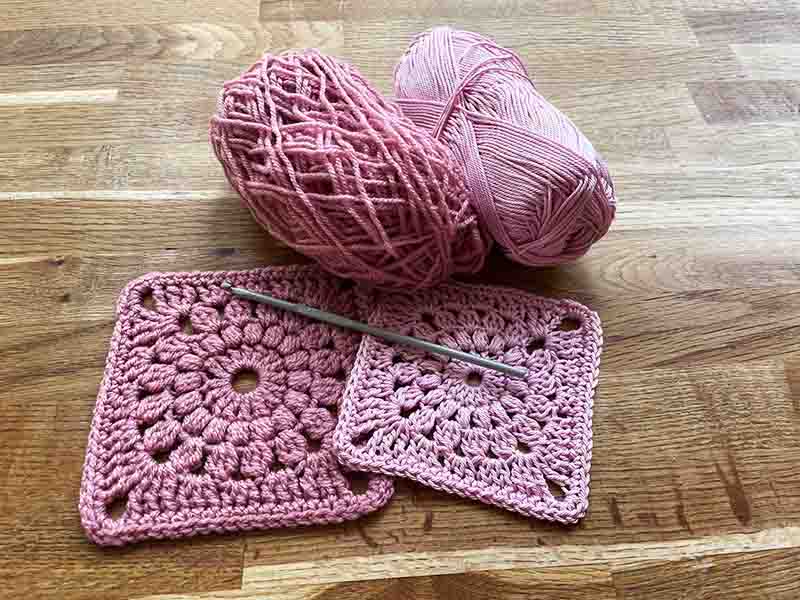
Working with acrylic vs cotton yarn
Some cotton and acrylic yarns feel very different to work with, and that means people tend to have strong feelings about working with one or the other. Mercerized cotton yarns are very smooth, making them a bit slippery to work with. But older cottons like Sugar ‘n’ Cream have the opposite problem. They are almost rough, making them a bit tough on your fingers.
Acrylics tend to divide opinion too. Some crafters love them, whilst others say the synthetic texture sets their teeth on edge. Some people also feel that they are a false economy, because they don’t last as well as natural fibers. My own opinion is that there are so many types of cotton yarn available to buy, and so many types of acrylic, that even if you’ve tried one and hated it, it’s worth trying a few others if you get an opportunity. A good way to do this is to look for yarn exchanges on social media, or in local community spaces like libraries.
Making your choice
When you’re working to a pattern that stipulates cotton or acrylic yarn, don’t swap for the other. As you can see in the photos for this article, it’s going to play havoc with your gauge, even if none of the other differences between them matter! For freestyle projects of your own design, consider these things:
Choose cotton for –
- Hardwearing items like storage baskets, purses and pencil cases.
- Items which need to absorb water, like dishcloths and facecloths.
- Clothes you’ll wear right next to your skin, like camisoles.
- Structured garments like boxy sweaters.
- Projects which focus on the sculptural quality of decorative stitches, like mandalas.
Choose acrylics for –
- Warm winter sweaters.
- Garments you can’t risk shrinking in the wash.
- Swimwear which is actually going to get wet (find out about specialist non-itchy synthetic yarns for making swimwear here).
- Items with high contrast color patterns.
- Big blankets, to keep costs down.
Still undecided? Then why not try a cotton acrylic blend, like Patons Cotton Blend 8-ply, or Rico Baby Cotton Soft DK, both of which are 50% cotton and 50% acrylic.
Summary
Acrylic yarns were really designed to work as substitutes for woolen yarns, not cotton ones. So, there are a lot of differences in weight, texture, and durability between cotton and acrylic. And whilst modern production methods have closed the gap between them a lot, you probably won’t mistaken one for the other any time soon! For this reason, think hard about what properties you need your crochet project to have before choosing a cotton vs acrylic yarn. And don’t swap one for the other when following patterns!
Let us know which of the two you prefer working with and why in the comments box down below 🙂


